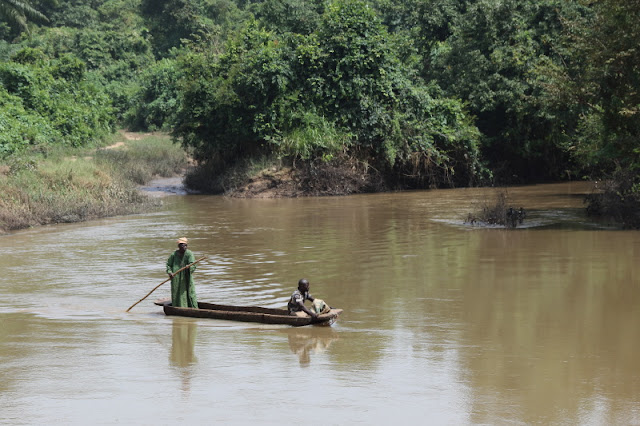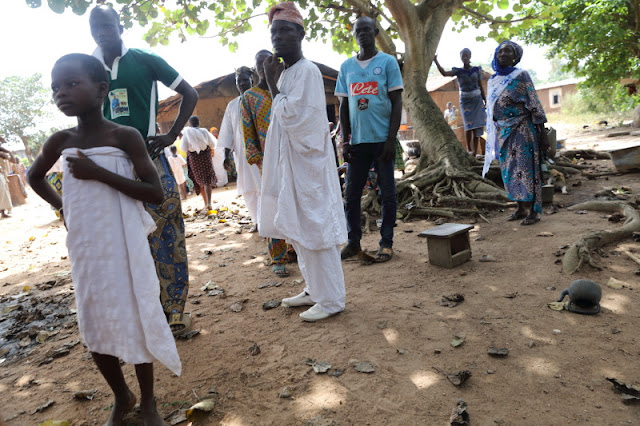 |
| treacherous waters |
Ile-Oba's children are familiar with the changing nature of the river and are good swimmers. First as babies, they have to stand the test of lineage belonging. If a mother of the clan has conceived a child whose father is an outsider, the child will not survive to its first ritual bathing.
But today is a strange day, a doomed day. Opeyemi's front tyre is flat and needs a repair. But that is the small part of the doom, this very morning a young girl, visiting from Oyo town on the occasion of the festival, has gone missing in the river. Sadness and embarrassment have taken over the place.
Festivities can't possibly carry on, the festival's procession is cancelled.
A few village elders are gathered under the shed build in the center of the village at the intersection of the two mud-roads leading to Ile-Oba. The concrete floor is demarcated by a low wall which serves as a bench. Wooden poles support the roof to provide shade. The shed is open to the wind from all directions, any rumor can flow in, be discussed and be carried away as it came. Everyone is rummaging on what happened. First, when did it actually happen? How can this young girl of 6 or 7 year old, the daughter of Mama Tosin, an Obatala follower, have been so stubborn this morning to go and play by the river with her four siblings and other children from Oyo town?
Early afternoon, as we arrive to Ile Oba in a bus, a man, dressed in white, comes gesturing and shouting angrily at us. What does he want? Next to him, a group of people equally dressed in white stand in the shadow by a blue taxi pick-up seasoned for the poor condition of the mud road during the rainy season. They all look abated. The man discloses to us information about the missing girl from his compound, the Obatala compound in Oyo. Mama Tosin has been told earlier that her daughter has been taken to the hospital, but she now knows that it was a lie, she understood that it is the river that carried away her child. She has been brought to a house to rest and bear her searing pain.
News that a child had gone missing by the river has spread quickly and all the men of the village have gone to survey the riverside and the river bed as good as they could. The Oba river is not any river. In the dry season, the water can be so low that only pools of muddy water remain, but now at the end of the rainy season the water flow is strong and the water can be deep in places. Some of the men go along the shores through the bush but come back empty-handed. Others will walk in the river and attempt to scan the bottom where the body of the girl could lie in the unlikely event that it has not been carried away. To no avail. The chocolate brown river won't reveal its secret.
We go to the place where the girl has disappeared, two men enter the water to show how deep it is in places, they raise their arms above their head and solemnly descend into the water. Very rapidly their heads disappear under the surface to show only their hands, which in turn are also swallowed under water. A few seconds later, both heads surface to catch some air. As they swim back we can see that the current is fairly strong.
Villagers expect that the body will resurface in two or three days. There is actually a place called the mouth of the river, where drowned bodies are traditionally converging and surfacing.
But the mystery remains, how did it happen? Obviously the children from Oyo were very excited to go and play by the river side. In Oyo town, there is a river too but the water only trickles and the whole bed is littered with generations of plastic waste among others.
Here the river is clean and powerful. Shortly after arriving from Oyo town, the children ran, a first time, with the other children from the village to the riverside and played with the dug-out canoe to cross the river. The parents fetched them and beat them, they forbade them to go there again on their own. Somehow the river had excited the kids' appetite for more fun, so the children quietly slipped out and went playing again. They were caught a second time and again beaten. This didn't help because the children went again and this time, fatally, the river carried Mama Tosin's daughter away.
 |
| not as quiet as it looks |
A few village elders are gathered under the shed build in the center of the village at the intersection of the two mud-roads leading to Ile-Oba. The concrete floor is demarcated by a low wall which serves as a bench. Wooden poles support the roof to provide shade. The shed is open to the wind from all directions, any rumor can flow in, be discussed and be carried away as it came. Everyone is rummaging on what happened. First, when did it actually happen? How can this young girl of 6 or 7 year old, the daughter of Mama Tosin, an Obatala follower, have been so stubborn this morning to go and play by the river with her four siblings and other children from Oyo town?
Early afternoon, as we arrive to Ile Oba in a bus, a man, dressed in white, comes gesturing and shouting angrily at us. What does he want? Next to him, a group of people equally dressed in white stand in the shadow by a blue taxi pick-up seasoned for the poor condition of the mud road during the rainy season. They all look abated. The man discloses to us information about the missing girl from his compound, the Obatala compound in Oyo. Mama Tosin has been told earlier that her daughter has been taken to the hospital, but she now knows that it was a lie, she understood that it is the river that carried away her child. She has been brought to a house to rest and bear her searing pain.
 |
| a village in disarray |
We go to the place where the girl has disappeared, two men enter the water to show how deep it is in places, they raise their arms above their head and solemnly descend into the water. Very rapidly their heads disappear under the surface to show only their hands, which in turn are also swallowed under water. A few seconds later, both heads surface to catch some air. As they swim back we can see that the current is fairly strong.
Villagers expect that the body will resurface in two or three days. There is actually a place called the mouth of the river, where drowned bodies are traditionally converging and surfacing.
But the mystery remains, how did it happen? Obviously the children from Oyo were very excited to go and play by the river side. In Oyo town, there is a river too but the water only trickles and the whole bed is littered with generations of plastic waste among others.
Here the river is clean and powerful. Shortly after arriving from Oyo town, the children ran, a first time, with the other children from the village to the riverside and played with the dug-out canoe to cross the river. The parents fetched them and beat them, they forbade them to go there again on their own. Somehow the river had excited the kids' appetite for more fun, so the children quietly slipped out and went playing again. They were caught a second time and again beaten. This didn't help because the children went again and this time, fatally, the river carried Mama Tosin's daughter away.
 |
| rushing to the cancelled party |
In the bus, Baba Adisa, an Obatala priest from Oyo town, was commenting that the missing girl was supported by her father Folare who is no longer living with the mother. He actually paid a handsome price for the girl's initiation. The girl was supposed to belong to Osun. What had happened was very unusual, there must be a secret about it.
To close the matter officially, Baba Adisa would have to go and inform the Palace of the Alaafin about what had happened. The Palace should in turn inform the police. Baba Adisa would also have to visit Folare, the father to inform him that his daughter had gone missing.
The next morning, Obadaisin, the Oba priest of Ile Oba Alaafin came to the Palace of the Alaafin so that the case could be cleared. It came out that the responsibility of the disappearance really lied on the parents who did not control their children.
To close the matter officially, Baba Adisa would have to go and inform the Palace of the Alaafin about what had happened. The Palace should in turn inform the police. Baba Adisa would also have to visit Folare, the father to inform him that his daughter had gone missing.
The next morning, Obadaisin, the Oba priest of Ile Oba Alaafin came to the Palace of the Alaafin so that the case could be cleared. It came out that the responsibility of the disappearance really lied on the parents who did not control their children.
Comments
Post a Comment